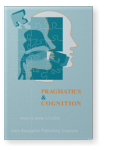Vol. 26:2/3 (2019) ► pp.239–266
The Liar Paradox in the predictive mind
Most discussions frame the Liar Paradox as a formal logical-linguistic puzzle. Attempts to resolve the paradox have focused very little so far on aspects of cognitive psychology and processing, because semantic and cognitive-psychological issues are generally assumed to be disjunct. I provide a motivation and carry out a cognitive-computational treatment of the liar paradox based on a model of language and conceptual knowledge within the Predictive Processing (PP) framework. I suggest that the paradox arises as a failure of synchronization between two ways of generating the liar situation in two different (idealized) PP sub-models, one corresponding to language processing and the other to the processing of meaning and world-knowledge. In this way, I put forward the claim that the liar sentence is meaningless but has an air of meaningfulness. I address the possible objection that the proposal violates the Principle of Unrestricted Compositionality, which purportedly regulates the conceptual competence of thinkers.
Article outline
- 1.Introduction
- 2.Motivating a cognitive-psychological treatment of the liar paradox
- 3.Predictive Processing and a dual account of language and conceptual knowledge
- 3.1The Predictive Processing framework
- 3.2The Language and Situated Simulation (LASS) Model
- 3.3The LASS model and Predictive Processing
- 4.A cognitive approach to the semantic paradox
- 4.1An assumption: Meaning as speaker meaning
- 4.2Two ways of conceiving of the liar paradox
- 4.2.1Conceiving in the LSM (linguistically focused prediction)
- Self-referential liar situation
- Non-self-referential liar situation: Yablo’ s paradox
- 4.2.2Conceiving in the WSM (semantically focused prediction)
- Self-referential liar situation
- Non-self-referential liar situation (Yablo’ s paradox)
- 4.2.3Accommodation effects: Explaining the psychological pull of the liar
- 4.2.1Conceiving in the LSM (linguistically focused prediction)
- 5.An objection: The Principle of Unrestricted Compositionality
- 5.1Argument from (material) inferential roles of category mistakes
- 5.2Argument from failure to formalise categorical restrictions
- 5.3Argument from scientific progress
- 6.Conclusion
- Acknowledgements
- Notes
-
References
